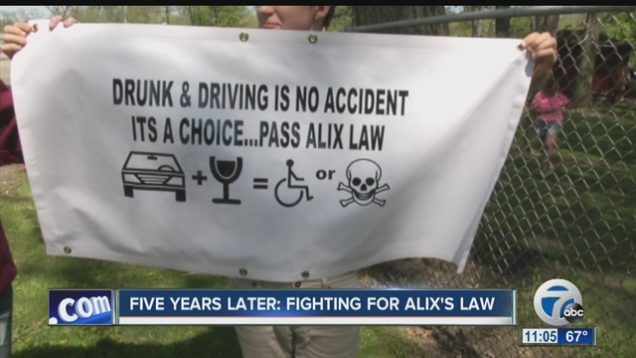Alix’s Law: Is the 7th Time the Charm?
On the night of July 8, 2011 18 year-old Alexandria “Alix” Rice died on the side of the road in a town just outside of Buffalo, New York. Alix was riding her longboard home from work around 11:20 pm when a drunk driver hit her and sent her flying 150 ft. from the point of impact, breaking both of her legs, some ribs, and lacerating her cerebellum. The driver, Dr. James Corasanti, a 55 year-old gastroenterologist sped away from the scene leaving Alix to die. Alix did not die alone though. Another motorist and his wife stopped to help Alix after seeing a car speeding towards Alix and then hearing an “almighty bang,” a sound the witness described as “ungodly.” Other residents of the usually quiet street reported hearing a “loud thump,” a “horrific noise,” and a “jarring sound” and many came out to help Alix. Dr. Corasanti however, did not stop. He drove home, cleaned Alix’s blood and flesh from the front of his $90,000 BMW, deleted some text messages, called an attorney, and 91 minutes later, turned himself into police.
At the police station Corasanti refused to submit to a blood test to determine his blood-alcohol level. Five hours later law enforcement officers were able to get a court order for Corasanti’s blood, which registered a .10 blood-alcohol content, .02 above the legal limit. Prosecutors charged Corasanti with second-degree manslaughter, second-degree vehicular manslaughter, leaving the scene of an incident without reporting, resulting death, tampering with physical evidence, and misdemeanor driving while intoxicated. During the trial experts testified that Corasanti’s BAC was likely between .14 and .21 when he hit Alix Rice. Evidence showed Corasanti had been texting and speeding when he hit Alix, though there was disagreement as to whether Corasanti crossed over into the bicycle lane where Alix was riding or if she had crossed into the road when she was hit. Yet, despite the significant weight of the evidence, Corasanti was acquitted of all charges except the misdemeanor DWI.
Dr. James Corasanti was drunk, texting, and speeding when he hit Alix Rice and left her for dead on the side of the road. How was he able to avoid all felony charges, including leaving the scene of an incident without reporting? The answer; a loophole in the law that only requires a driver to stop if they know or have reason to know that a person has been injured, or that damage has been done to property as a result of a motor vehicle accident. The current law gives drivers an incentive to leave the scene of an accident because in order to convict, prosecutors must prove that anyone in the driver’s position must have known that they hit a person. Corasanti and his defense team were able to convince the jury that there was reasonable doubt as to whether Corasanti knew that he hit a person. Corasanti claimed that his BMW was designed to cancel out noise and therefore he did not hear the impact of his car hitting Alix’s body. Dr. Corasanti was sentenced to one year in jail despite killing Alix Rice.
 Lawmakers and the public were outraged. Looking for a way to close the loophole that allowed Corasanti to receive such a minimal sentence, New York State Senator Patrick Gallivan introduced Alix’s Law, Senate Bill 7577-A in 2012. Alix’s Law is designed to prevent drunk drivers from hitting something or someone, leaving the scene, and then being able to claim that they did not know that any injury or property damage occurred. The bill holds drunk drivers responsible for leaving the scene of an accident. Alix’s Law, adds the following language to the current statute:
Lawmakers and the public were outraged. Looking for a way to close the loophole that allowed Corasanti to receive such a minimal sentence, New York State Senator Patrick Gallivan introduced Alix’s Law, Senate Bill 7577-A in 2012. Alix’s Law is designed to prevent drunk drivers from hitting something or someone, leaving the scene, and then being able to claim that they did not know that any injury or property damage occurred. The bill holds drunk drivers responsible for leaving the scene of an accident. Alix’s Law, adds the following language to the current statute:
“A person operating a motor vehicle in violation of section eleven hundred ninety-two of this chapter that came into contact with a person, real property, or personal property, that resulted in damage to real property or to the personal property, not including animals of another, shall be presumed to have known or have cause to know of such contact and of such damage, unless such person shows that they would not have known or had cause to know of such contact and of such injury regardless of intoxication or impairment by the use of alcohol or a drug.”
The new language creates a rebuttable presumption that an intoxicated driver who is involved in an accident knows that they have caused damage or injury and therefore they must stop and report the accident to police. The current law is the opposite. In order to convict someone for leaving the scene of a fatal accident, the prosecution has the burden of proving that the driver knew or should have known that they hit a person. This law makes it easier to prosecute people for leaving the scene of an accident they caused while driving drunk. Alix’s Law passed in the Senate on June 19, 2012 and was sent to the Assembly where it died in the Transportation Committee.
Alix’s law was reintroduced in 2013, 2014, 2015, and 2016. Each year Alix’s Law has received unanimous, or near unanimous support from the Senate. In 2016, Alix’s Law passed 58-0 in the Senate before it stalled in the Assembly. In 2017 Sen. Gallivan introduced Alix’s Law for the 6th time as S. 3393-A. The same bill was introduced in the Assembly as A.1944 by Assemblywoman Crystal Peoples-Stokes. Alix’s Law passed 61-0 in the Senate in 2017, but again died in Assembly. Alix’s law was returned to the Senate, and as of February 6, 2018, it was back in the Senate Transportation Committee.
It is not clear why Alix’s Law has yet to move out of committee in the Assembly after passing unanimously on six different occasions in the Senate. Assemblywoman Peoples-Stokes told reporters that counsel for the committee has advised that Alix’s Law is unnecessary and that the law already covers what Alix’s Law is trying to change. However, a former acting Erie County District Attorney points out that the law would change the incentives for people to leave the scene of an accident, and would help close the loophole that allowed Dr. Corasanti to avoid felony charges. Additionally, there have been a number of high profile hit-and-runs in the past few years, and so it may be time for the legislature to take action and to address the problem. Whether or not Alix’s Law will ever pass the assembly is yet to be seen, but Sen. Gallivan and the Rice family continue to advocate for Alix’s Law and are committed to keeping Alix’s memory alive.
 Meghan Hayes anticipates graduating from Boston University School of Law in May 2019.
Meghan Hayes anticipates graduating from Boston University School of Law in May 2019.
Breaking Chain Migration: An Affront to the New Colossus?
In February 2018, the United States Citizenship and Immigration Services, the federal agency that grants green cards and U.S. citizenship, revised its mission statement by striking its characterization of the United States as a “nation of immigrants.” The phrase dates back to the 1800s and was popularized by President John F. Kennedy, who sought to remind Americans of the monumental contributions that immigrants have made to America. The removal of this iconic language is consistent with the President Trump’s “America first” agenda, including efforts to limit immigration by proposing to end or alter the Deferred Action for Childhood Arrivals (DACA) program, ban immigration from several majority-Muslim countries, and build a wall along the Mexican border. This anti-immigration attitude has also led to attempts to curtail the family visa program, which allows U.S. citizens and permanent residents to sponsor certain family members applying for lawful permanent residency in the United States.
President Trump recently made immigration policy a priority with congressional leaders at Camp David, emphasizing his desire to end the “horrible system” of family sponsored visas, which he refers to as “chain migration.” Now, in exchange for softening their proposal to deport DACA recipients, President Trump and the Republicans are targeting the lower priority F3 and F4 category family visas, arguing that they threaten national security. In fact, President Trump blamed chain migration, also known as “family reunification,” for the terrorist attack on New York City in December 2017. The perpetrator of that attack entered on an F43 visa, the lowest priority family visa category reserved for children of parents who are sponsored by a direct relative who is a U.S. citizen. While the U.S. issues an unlimited number of visas to close relatives of U.S. citizens, the number of visas allotted for extended family, or “chain migrants,” is capped at 226,000 per year.
The political rhetoric surrounding chain migration has stoked fears about national security and who is entering the United States through family sponsored visas. But historically, the concept of chain migration was actually simpler and less nefarious than it has recently become. The term “chain migration” was coined as a politically neutral term in the 1960s and stands for the proposition that people are more likely to move to where their families live. Although opponents of family sponsored immigration often use “chain migrant” to denote any immigrant relative of a green card holder or U.S. citizen, the modern technical usage refers to extended relations and not immediate family.
 Interestingly, conservatives originally supported family sponsored immigration through the Immigration and Naturalization Act of 1965. The Act replaced the nationality quota system, which many viewed as overtly racist, with the family reunification program. Around 1960, immigration from Europe began to decline as the continent became more prosperous. Conservatives hoped that the new program would encourage European immigrants to bring their families to the United States. Today, only about eleven percent of immigrants are European, with forty-four percent coming from Eastern Europe, including First Lady Melania Trump and her parents. Meanwhile, the overall majority comes from Asia and Latin America.
Interestingly, conservatives originally supported family sponsored immigration through the Immigration and Naturalization Act of 1965. The Act replaced the nationality quota system, which many viewed as overtly racist, with the family reunification program. Around 1960, immigration from Europe began to decline as the continent became more prosperous. Conservatives hoped that the new program would encourage European immigrants to bring their families to the United States. Today, only about eleven percent of immigrants are European, with forty-four percent coming from Eastern Europe, including First Lady Melania Trump and her parents. Meanwhile, the overall majority comes from Asia and Latin America.
While concerns about protecting national security are real, the visa category is not as important as the screening process itself. The screening process for family sponsored visa applicants is extensive. Applicants must submit to background checks and be evaluated on the likelihood that they will become an economic liability to the state. In addition, immigrants must have a financially stable relative vouching for them, with a household income of at least 125% of the poverty line including the visa applicant. Finally, because of nationality caps and visa backlogs, it can take many years to bring extended relatives to the United States. This limits the potential to build chains of immigrants, especially from countries like Mexico that have many more qualified applicants than distributable visas.
Although no safeguard is perfect, the potential for chain migration to overwhelm the U.S. is more limited than the Administration’s rhetoric would suggest. Unfortunately, this raises the question whether the fierce opposition to immigrant families is truly about security, or whether a fear of cultural and ethnic change is prompting the effort to end the family reunification program.
As of 2014, Hispanics and Asians are the fastest growing groups in the nation for two separate reasons. Hispanics have a higher fertility rate once they arrive in the United States, while Asian immigrants arrive in the greatest numbers. Meanwhile, the percentage of white Americans is declining. All of this suggests that immigration is making America more diverse and less familiar to white Americans, who make up eighty-one percent of the 115th Congress but just sixty-two percent of the U.S. population. In the House of Representatives, Democrats have eighty-three minority members while the Republicans have only twelve, despite holding forty-five more seats as of January 2018.
It is unclear how the Democrats will handle Republicans’ demands for ending the F3 and F4 family sponsored visa programs. Eliminating those visas may be the price of protecting the 800,000 individuals enrolled in DACA. However, Republicans have also run into trouble with this negotiation tactic. As recently as April 25, 2018, a federal judge in the D.C. Circuit decided that the DACA program must remain intact unless the Department of Homeland Security can explain why DACA is “unlawful” within ninety days. If the courts uphold DACA then its effectiveness as a bargaining chip against the family sponsored visa program is greatly diminished.
As an alternative to chain migration visas, President Trump has proposed both cutting immigration overall by forty-four percent over the next fifty years, and shifting to a merit-based immigration system. Republicans have also introduced bills to limit family sponsored immigration and increase the number of merit-based employment visas. Democrats are unlikely to accede to cutting immigration so drastically, and shifting to a merit-based system could imply breaking up families. However, the merit-based system has been successful in Canada, where emphasis on immigrant contributions has popularized immigration as a whole. In fact, Canadians feel significantly more positive about immigration than do many Americans. Canada proportionally accepts about three times more immigrants than the United States, but saves about two-thirds of the slots for merit-based applicants. This may have economic advantages, but it raises humanitarian concerns. On the other hand, if the alternative is slashing immigration across the board, then it might be a necessary compromise. Switching to a merit-heavy system, however, may signal an end to the democratic values of an America that once prided itself, at least superficially, on welcoming the tired, poor, huddled masses yearning to breathe free.
 Caitlin Britos anticipates graduating from Boston University School of Law in May 2019.
Caitlin Britos anticipates graduating from Boston University School of Law in May 2019.
A Lackluster Response to the 64,000 Opioid Overdose Deaths Per Year
The Opioid Epidemic stands apart from past drug crises this country has experienced. Not only is this the deadliest drug crisis the country has experienced, this epidemic is a result of a “perfect storm.” A shift in the medical field to focusing on the treatment of pain changed opioid prescribing practices and encouraged an increase in marketing practices of opioid pharmaceutical companies, resulting in America being the world’s leader in opioid prescriptions. Congress, through the Bipartisan Task Force to Combat the Heroin Epidemic, made some progress addressing opioids during the Obama Administration, but with the change in administration the efforts seem stalled.
In 2015, doctors prescribed enough opioids to medicate every American around the clock for three weeks. Even as doctors started to prescribe fewer opioids, in 2016 enough opioids were prescribed to fill a bottle for every adult in America. The increase in opioid prescriptions came at the same time as there was a shortage of workers in addiction and recovery, allowing for only 10 percent of Americans with substance use disorder to receive the necessary treatment. This “perfect storm” created a massive swell in opioid addictions. As it became more difficult to obtain prescription opioids, addicts sought a stronger high and many turned to illegal opioids, such as heroin and fentanyl. Nearly 80 percent of Americans addicted to heroin started with misuse of prescription drugs.
The death of Philip Seymour Hoffman in 2014 from a heroin overdose put a spotlight on the crisis. Despite recognizing that there was a nation-wide epidemic, the country took a lackluster response and overdose deaths continued to spike. The National Center for Health Statistics, Centers for Disease Control and Prevention, and the National Institute on Drug Abuse have reported only an increase in the overdose deaths. The U.S. government estimated about 64,000 overdose deaths for 2016. With the epidemic claiming a record number of lives per day, all of the 2016 presidential candidates spoke about personal stories or plans of action for combatting the epidemic. Most of the candidates agreed that the federal government should provide resources to the states to help combat the epidemic with a focus on treatment. Some of the other candidates focused on stopping the flow of drugs coming across the border, including now President Donald Trump.
In March 2017, President Trump established the President’s Commission on Combating Drug Addiction and the Opioid Crisis. The Commission members include Former Governor Chris Christie of New Jersey, Governor Charlie Baker of Massachusetts, Governor Roy Cooper of North Carolina, Former Congressman Patrick Kennedy of Rhode Island, Professor Bertha Madras, and Florida Attorney General Pam Bondi. On November 1, 2017, the Commission issued a final report with more than 50 recommendations (see, page 7). They included increasing data sharing of state-based prescription drug monitoring programs, changing privacy regulations to allow healthcare providers easier access to information about patients with substance use disorder, equipping all law enforcement officers with naloxone, and enforcing the Mental Health Parity and Addiction Equity Act. In addition, the Commission recommended a national multi-media campaign to help fight the epidemic, more federal funding for the states, drug courts in every federal district court, and enhanced penalties for drug trafficking to reduce the supply of opioids.
Even prior to the issuance of the report, President Trump declared the Opioid Epidemic a public health emergency. The President stated “[t]he best way to prevent drug addiction and overdose is to prevent people from abusing drugs in the first place. If they don’t start, they won’t have a problem,” but until his 2019 budget proposal the President’s Administration failed to request funding to combat the epidemic. Congressman Patrick Kennedy, a vocal critic of the limited action taken by the President, explained, “[t]he emergency declaration has accomplished little because there’s no funding behind it. You can’t expect to stem the tide of a public health crisis that is claiming over 64,000 lives per year without putting your money where your mouth is.”
The President’s focus has been on increasing funding for law enforcement. On January 10, 2018, the President signed the INTERDICT Act which provides funding to U.S. Customs and Border Protection to assist with the detection and interception of illicit fentanyl. Increased enforcement may be part of the solution, but some Congressional leaders believe there is more than just one solution and have said the epidemic must be addressed on many fronts.
In 2015, Representatives Ann McLane Kuster and Frank Guinta from New Hampshire, a state that has the highest fentanyl overdose deaths per capita, created the Congressional Bipartisan Task Force to Combat the Heroin Epidemic. From its inception, the task force has gained members from both parties, and now has more than 100 members. The Task Force pushes a legislative agenda, as well as holds informational hearings. Under President Obama’s Administration, the Task Force was able to pass several pieces of legislation, including the 21st Century Cures Act, and the Comprehensive Addiction & Recovery Act (CARA). The CARA Act is currently the main source of funding for the opioid epidemic, but the funding will run out in 2018. In response to the “perfect storm” that created this epidemic, CARA has six pillars of response, including prevention, treatment, recovery, law enforcement, criminal justice reform, and overdose reversal.
On January 10, 2018, the Task Force released its 2018 legislative agenda. The agenda includes bills focusing on prevention, treatment, law enforcement, and prescribing practices. Several of the bills include federal funding and grants. After the Task Force called for an increase in funding to combat the epidemic, Congress passed $6 billion in the 2018 budget. Some have been critical of the amount of funds dedicated to the epidemic, and compared it to the $24 billion a year that was dedicated to addressing the HIV/AIDS crisis.
On February 9, 2018, Purdue Pharma, the maker of OxyContin, announced it had laid off employees whose job was direct promotion of the drug to doctors. Purdue Pharma is currently facing dozens of lawsuits for deceptive marketing practices. It is unclear if the company’s change in promotion practices will alter prescribing practices of doctors, who are already familiar with the drug. To make a significant impact on the epidemic, real change needs to happen outside of Purdue Pharma’s promoting practices.
The U.S. Surgeon General issued a public health advisory encouraging Americans to routinely carry naloxone on April 5, 2018, which is the first advisory issued since the 2005 warning against drinking alcohol while pregnant. Access to naloxone would come in part from the $6 billion in the 2018 budget which has allocated grants for naloxone so states can hand it out for free; however, there is also reliance on naloxone manufacturers keeping costs low. The Surgeon General explained that naloxone can be a “touch point that leads to recovery.” However, more in line with the Trump Administration, the Surgeon General believes that the involvement of law enforcement is necessary to solving the epidemic.
A tough-on-crime approach and focus on providing funding strictly for law enforcement, as President Trump has encouraged, is not the answer. The country responded to the crack cocaine drug crisis with a tough-on-crime approach and strict sentencing guidelines. That led to extraordinary incarceration rates, especially for African Americans, and failed to address the issue of addiction as a disease. The country should learn from its mistakes, take a more well-rounded approach, as suggested by the Surgeon General and the Bipartisan Task Force, and implement a long-term solution. Congress must not only provide funding for law enforcement, but should increase treatment and recovery for substance use disorder, implement better prescription drug monitoring programs, start country-wide drug court programs, and educate Americans and doctors about the disease of addiction and risk of opioids. People are dying every day in this country from opioid overdoses, and every time Congress delays we lose another life.
 Mikayla Foster anticipates graduating from Boston University School of Law in May 2019.
Mikayla Foster anticipates graduating from Boston University School of Law in May 2019.
Data Breaches: A Growing Problem, but Will Congress Act?
Data breaches are a growing and ongoing concern. As of the modern economy relies more heavily on web-based services, hackers throughout the world are finding innovative ways to exploit this new technology for their own gain. The big question is: will Congress act to address the problem?
Recent data breaches have drawn the ire of members of Congress, including the Equifax hack and Facebook’s privacy issue with Cambridge Analytica, largely because of perceived wrongdoing or an inadequate response on the part of the breached company. Data breaches are tricky because, on the one hand, the breached company is the victim of a criminal act which should be investigated and prosecuted. But, on the other hand, to the extent that a company is breached because it was negligent or even reckless in failing to patch a known security flaw, some kind of legal consequence seems appropriate. Crafting a legislative response to address data breaches is an intricate matter that begins with an important question: as a matter of federalism, are data breaches a state or federal concern?
A vast majority of states have laws on the books requiring a breached company to take some kind of action after a security breach. These laws define “personal information” and require that notice of the breach is given to either breached consumers or a state government entity such as the Attorney. States wielding their police power to regulate the response to data breach incidents makes sense because data breach litigation is usually focused upon a theory involving negligence, privacy invasion, or breach of a fiduciary duty (Solove & Citron, at 8). Each of these causes of action are firmly rooted in state law. Yet, the patchwork approach to data breach legislation leaves many companies scrambling to comply with very different laws in the various jurisdictions where individuals with breached data reside.
Yet, many data breaches end up litigated in federal court. The most common reason for this is the Class Action Fairness Act (28 U.S.C. §§ 1332(d), 1453(b); “CAFA”), which provides a federal forum to claims where the parties maintain minimum diversity (at least one plaintiff located in a state different from at least one defendant) and an amount in controversy of at least $5 million. Because many data breaches impact a disparate plaintiff class residing throughout the country, and because the sought-after remedy is much larger than $5 million, these cases are frequently removed to federal court.
Other data breaches are litigated in federal court from the start, with causes of action arising under federal statutes. Claims are often brought under Fair Credit Reporting Act (15 U.S.C. § 1681 et seq., “FCRA”), which requires companies that send information to credit reporting agencies to take “reasonable procedures” to protect the confidentiality of sensitive personal information. The federal government also regulates data security in several industries, including the healthcare industry through the Health Insurance Portability and Accountability Act (Pub. L. 104–191, “HIPPA”) and the financial services industry through the Gramm-Leach-Bliley Act (Pub. L. 106–102, “GLBA”). Lastly, the Federal Trade Commission (“FTC”) regulates some data security matters pursuant to the agency’s authority to prosecute unfair competition.
These statutes make clear that the federal government has some role to play in the data security sphere, and with good reason – data security can quickly become a matter of national security. First, many data breaches are thought to involve state-sponsored actors, implicating international law and sovereignty concerns. Next, data breaches can give rise to other federal crimes, including identity fraud (Internet Research Agency Indictment; Counts 3-8 at ¶¶ 96-98). When that identity fraud was apparently perpetrated with an intent to interfere in America’s free and democratic elections, the concern is only exacerbated.
So, what can Congress do to address this issue? While the problem is very complex and requires an equally complex response, Congress often prefers to address problems in a piecemeal fashion. There have been two bills put forth, one from Senators Nelson, Blumenthal, and Baldwin, and another from Senators Warren and Warner. It is important to note that the two bills cover different topics under the greater umbrella of data privacy – they are not mutually exclusive and they are not merely two different solutions to a single problem.
Senator Nelson’s bill, called the Data Security and Breach Notification Act, would require the FTC to establish minimum “policies and procedures regarding information security practices for the treatment and protection of personal information.” § 2(a)(1). This bill includes provisions that exempt financial institutions in compliance with GLBA, but it covers a large number of different organizations and industries. It also creates a series of new penalty provisions authorizing fines up to $5 million for infractions. Notably, § 7(a) dictates that this bill would preempt state information security laws. This provision is sure to be unpopular with certain states, especially those (like Massachusetts) that have been proactive in regulating data at the state level (see the testimony of Sara Cable, Assistant Mass. AG, to the U.S. House of Representatives’ Financial Services Committee, Part II.C, page 4).
Senator Warren’s bill has a narrower scope, addressing only “credit reporting agencies” with annual revenue “not less than $7 [million]”. § 2(4). After the Equifax breach announced in the Fall of 2017, the credit reporting agencies themselves became the focus of new scrutiny. Given the immense volume of sensitive information that these agencies possess, and their critical role in our financial system, it makes sense that these entities should satisfy more exacting standards. Senator Warren’s bill would establish an “Office of Cybersecurity” within the FTC, and that office would be charged with promulgating regulations and investigating non-compliance with those regulations. §§ 3(b)(B), (D). The bill also contains a fairly restrictive notification requirement – mandating that covered credit reporting agencies alert customers within 10 days after a breach. § 4(a). Such notification requirements present interesting policy question. On the one hand, the sooner customers know of a breach, the sooner they can take action to prevent identity theft and fraudulent use of their finances. On the other hand, in countries like Australia that have recently implemented mandatory notification laws, companies have expressed concern that such a notification would amount to an “admission of guilt” that may come back to haunt the company in subsequent litigation.
Though there are many issues underlying data privacy and security, one thing is clear – something must be done. Because these bills address different areas of cybersecurity, they should both pass. Even if that were to happen, much more needs to be done. States undoubtedly have an important role to play, but it is much faster and more efficient for federal legislation to address an issue like this that impacts citizens nationwide. But, what precisely needs to be done, however, is a much more complex question. The 115th Congress has been derided for its lack of action on many important issues, including an immigration fix for DACA recipients and addressing firearms in the aftermath of the Parkland shooting. So, will anything actually happen? Only time will tell.
 David Bier plans to graduate from Boston University School of Law in May 2019.
David Bier plans to graduate from Boston University School of Law in May 2019.




